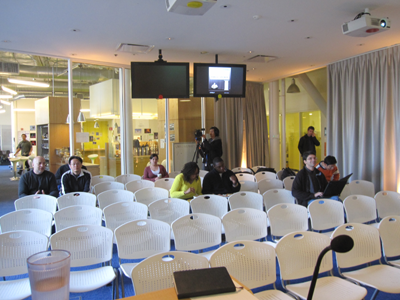My post on why the future of UI will be boring has upset people. I clarified that although my prediction is depressing in a way, I don’t make it because I like it. It’s simply that I believe the most honest view of the future is that there are limits to progress in everything, we just don’t know what they are.
One of the best critiques of what I wrote is from Baldur Bjarnason:
What I’m arguing is that automobiles are specialized machines and that automobile users (AKA drivers) have years of highly specific practice which creates a lock-in quite unlike that you see in computing. Computers are different sort of tools with different sort of uses. Umbrella handles and door knobs do not require skill or training and have converged on a simplistic optimal design.
The lack of change in the industries you cited have nothing to do with what might hold back innovation in computing. That is, they did not prove your point in any way. They were non sequiturs.
They are non sequiturs only superficially. I believe there is a pattern of limits on change that effect most industries, ideas, and things. Physical interfaces in particular have natural limits on how they are likely to work. It’s possible to overcome them, but it’s unlikely.
Here are some more seeming non-sequiturs, but bear with me for a moment.
There is a reason all airplanes have wings. The contact point, or interface, between the plane and the air has certain unavoidable properties. Although wings have changed much in 100 years, they are fundamentally the same kind of interface model, or metaphor. Why? The fundamental principles of physics at work have not changed. If someone asked, as Gruber did “why have we had the same interface model for airplanes for 50 years?” I’d give the same answer. And yes, I know we have helicopters . Arguably a chopper blade is a kind of wing, but that’s a thin, ha ha, pun intended, argument. A better argument is this: have they replaced airplanes?
And even if we invented a superior wing that was all loops and circles and made of lightweight edible alien space cheese/steel, how long would it take to for the majority of airplanes to use that new design? 10 years? 30? It takes a long long time for people to replace things in sufficient quantities to become the dominant design. It’s expense too. And it’s not great for the environment to replace working things with new things that are only marginally better. It may blow your mind to consider the history of innovation in electric plugs: why so many that do the same thing? the social costs of change outweigh the thrill of “innovation”.
Cars and trucks have wheels, a wheel being perhaps the most efficient way to bring power from the engine into reliable contact with a road. It’s a safe bet, given the fundamental nature of roads and engines, that wheels will be with us for a long time, even as cars change greatly in other ways. Wheels are about 3000 years old. I’m doubtful we will innovate our way out of using wheels for most heavy moving objects. The wheels might be made of unobtanium, or fried chicken, or there might be two wheels or 40, but wheels they will be.
When it comes to desktop computing, the human body is the interface. Given the constraints of our fingers, hands, elbows, and eyes, and our need to use character based languages, plus the dominant activity of reading and writing when at our desks, there are constraints on what kinds of designs can work well. Minority Report UI and VR are un-likely to ever be dominant for ergonomic reasons (still looking for any evidence from makers of these things that they are ergonomically sound) – fun to watch, fun to play with, good for niche situations, but if you did it for hours a day your elbows would melt. They also don’t do much to improve email, or reading web pages.
Odds are good most change will occur in places where there are fewer physical limits.
I’d concede there is more room for UI innovation in mobile computing, or even in gaming, than desktop computing, simply because unlike the desktop, we’ve spent much less effort designing for those physical environments and interactions. There is way more uncharted territory to cover, but even there, the human body is one unavoidable constraint to big ideas. New things born from dreams inevitably interact with the limitations of hands and eyes, constraining the range of designs likely to be successful. And even if those mobile and gaming devices see radical new discoveries, only some will transfer back to the different constraints of desktop computing.
Shell wrote, in the comments:
Will we still be using keyboards in 20 years time? Probably, in some form. We also still use pens and paper after 1000s of years too.
The UI of a pen is a great example. The reason why pens are the same has less to do with what’s possible technologically, or that there aren’t amazing ideas out there, but more to do with with the limitations of good interfaces for human hands. The highest-tech pen I’ve seen, the LiveScribe, which has a ridiculous number of interesting ideas in it, has the same core physical interface and interaction model of the ball point pen I used in high school.
And the last argument for the limits of innovation has to do with human nature. Why we choose to adopt things is not a logical process, and is fueled by culture, psychology, timing, and a dozen factors, many which have little to do with new idea X being better than old idea Y in technological or design terms. Those are terms technologists and designers obsess about, despite history’s strong suggestion that those factors are overestimated in their role for what becomes dominant, and when.
The simple question of what it would take Apple, Microsoft and Logitech, three companies that dominate the business of keyboards, mice, and GUIs, to abandon those well understood designs and businesses in favor of something new. Or for a new venture to choose to compete against the entrenched powers of those three. And then to be successful at it beyond a niche capacity. The human elements around adoption of innovation are just as formidable as the technological or design ones, especially when we’re talking about the wholesale replacement of one metaphor for doing things with another.
Progress is great. Show me something better and I’ll champion it with all my heart. Explain to me the problem we need to solve and I’ll advocate for its elimination at the top of my lungs. I’m thrilled to see experiments, and risks and people who say damn the odds I’m building it anyway. I’m a damn the odds kind of guy. But before we herald anything as the next whatever, lets be honest about what we have, what the real problems are, what’s involved in change, and what’s likely to happen. I can’t see any other credible way to improve the odds of progress.





